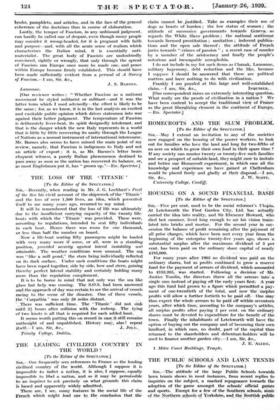THE . LOSS OF THE `. TITANIC '
[To the Editor of the SPECTATOR.] SIR,—Recently, when reading in Mr. J. G. Lockhart's Peril of the Sea his vivid account of the shipwreck of-the ` Titanic ' and the loss of over 1,500 lives, an idea, which presented itself to me many years ago, recurred to my mind. -
It will be remembered that the loss of life was ultimately due to the insufficient carrying capacity of the twenty life- boats with which the Titanic ' was provided. These were, according to regulations, intended to seat fifty individuals in each boat. Hence there was room for one thousand, or-less than- half the number on board.
Now a life-boat seating fifty passengers might be loaded with very many -more 'if' some, or all, were in a standing position, provided security against lateral instability was attainable. The weather conditions were unusual. The • sea was "like a mill pond," the stars being individually reflected on its dark surface. Under such conditions the boats might have been roped together, side by side, bow and stern, gaining thereby perfect lateral stability and certainly holding many more than the regulation complement.
It is to be borne in mind that not only was the sea like glass but. help .was coming. The S.O.S,_ had been answered and the approach of.day was certain to see the arrival of vessels racing to. the scene of the disaster.. One of these vessels,
the ,` Carpathia ' was only 58 miles. distant. ., ,,Ther e was sufficient_ time. The Titanic '. did not sink until 21 hours after collision with the iceberg. The . tying of two knots is all that is required for each added, boat.. It seems worth putting this on record in case. it still remains unthotight of and unpublished. History may, alas ! repeat








































 Previous page
Previous page